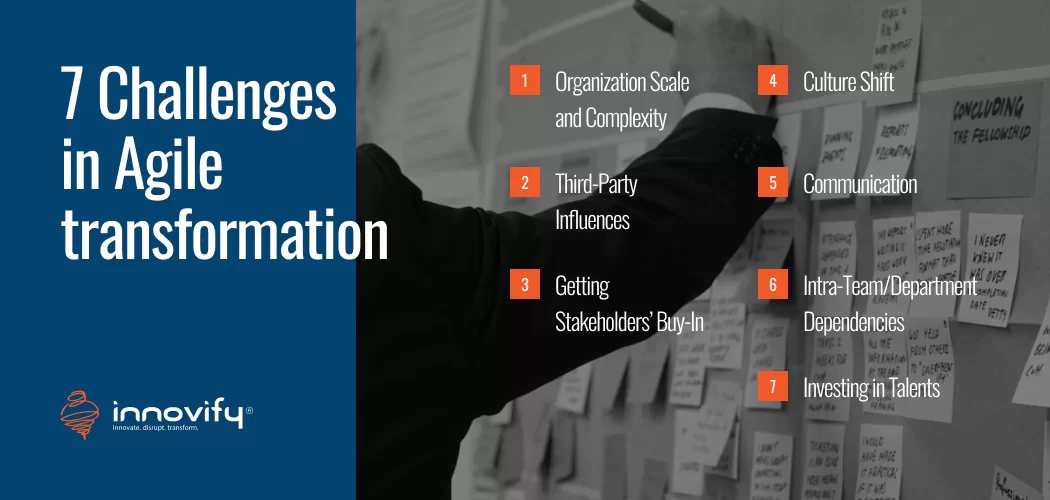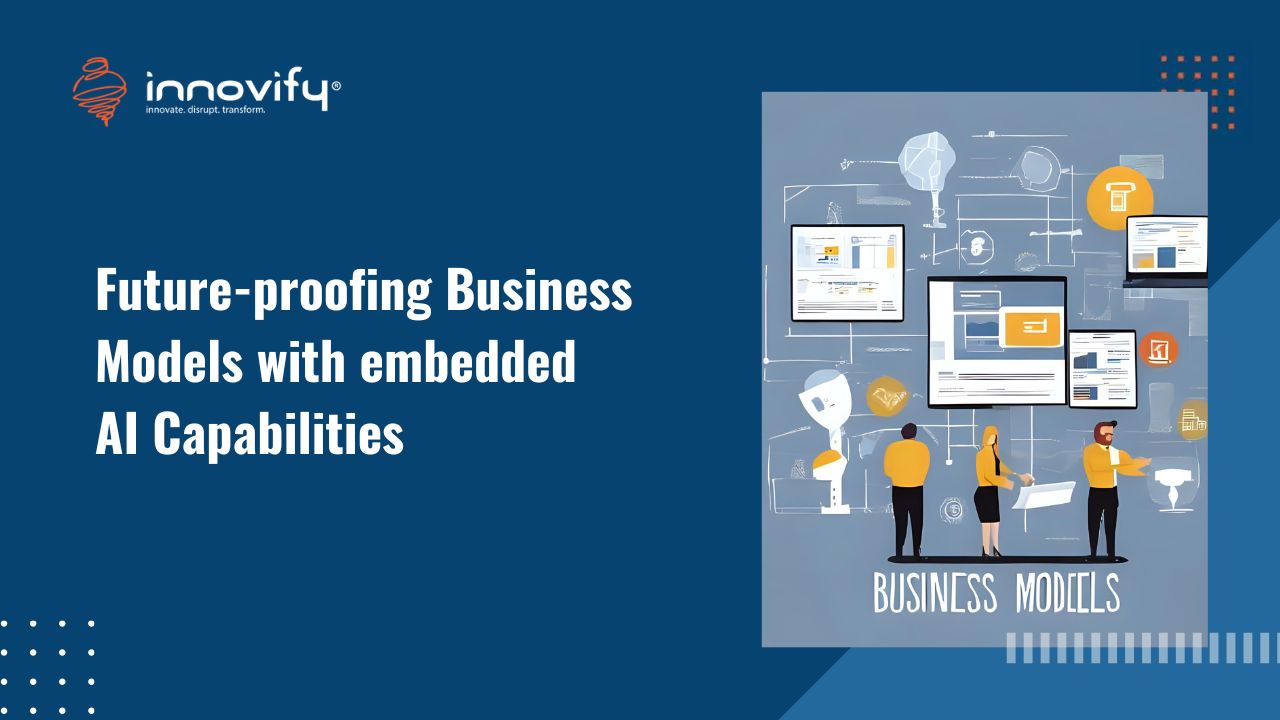AI/ML
Agile transformation challenges and stratigies to overcome them
Agile methodologies have become increasingly popular among businesses seeking to improve efficiency and responsiveness. However, business transformation to Agile can be challenging, and organizations may encounter several obstacles. In this article, we explore the most common challenges that businesses face when undergoing an Agile transformation. We provide effective strategies and best practices to overcome these challenges, regardless of the size or industry of your organization.
We understand the challenges of Agile adoption and the importance of a successful transition. We’ve compiled our team’s expertise and experience to create a comprehensive guide to help you navigate the complexities of Agile transformation.
Whether you’re struggling with Agile adoption challenges or looking to enhance your Agile practices, then don’t worry; this article offers valuable insights to help you succeed. Join us as we explore the Agile transformation challenges, identify their causes, and provide actionable solutions to help you become more agile, efficient, and competitive.
How to Overcome These 7 Challenges in Agile Transformation
It’s true that remaking big, complex business processes isn’t straightforward; the same goes for Agile transformation.
Many organizations begin by trying to change culture or behavior, but those techniques aren’t enough and usually don’t succeed. Because Agile project management and processes require a certain setting to be effective, companies must first address the corporate structure and alignment.
Most organizations attempting to adopt Agile framework at any level are not equipped with the required structure—hence, certain common barriers will appear on the way to achieving it.
In this article, we’ll discuss the common Challenges in Agile Transformation companies face while adopting Agile methods.
So let’s not wait any longer.
7 Challenges You’d Face During Agile Transformation
We’ve seen companies facing the following issues & challenges with agile transformation journey:
1. Organization Scale and Complexity
Agile transformation journey is often challenging, whether you are big or small. Because you are small doesn’t mean that Agile Transformation becomes an instinctive process—or easy to accomplish. It might, however, is easier than large-scale companies.
Large organizations that serve numerous platforms and products have such a tangled structure that change often begins from a very messy position. Untangling these things is important, and it does not occur instantly.
No matter how straightforward it seems, large-scale organizations must be realistic about the fact that size and complexity will negatively impact their agile transformation journey.
Overcoming the Challenge
Organizations with large-scale operations need to understand “what the transformation process looks like” before embarking on the process.
The extent to which the shift to agility involves numerous efforts, or the pace at which it changes, may vary based on the infrastructure of the organization, the current condition of the processes, the experience and knowledge of the leadership teams, engineers, and so on. The transition, nevertheless, involves the following common phases:
- Grow awareness about Agile transformation within the organization
- Put efforts into creating a strategy with the future working style
- Implement pilot projects and test them out
- Scale and improve
2. Third-Party Influences
Third-party influences cause the majority of Issues with Agile transformation. Many organizations are forced to work with partners who do not or cannot switch to an Agile Delivery Method because of either fixed-outcome or fixed-price contracts.
Hence, if you are forced to work with a supplier who is reluctant to embark on the agile transformation journey with you, you may encounter problems.
Overcoming the Challenge
The simplest approach to follow is to renegotiate with the contractor. Otherwise, you can look for some other contractor who follows Agile or is ready to follow Agile.
Agile emphasizes discovering requirements and improving solutions in the modern software development ecosystem. While this is fantastic, these tasks are accomplished in a collaborative method. Therefore, Agile is usually preferred by suppliers in projects divided into smaller parts.
Because of this, you should overcome the issues & challenge with Agile transformation when trying to convince your supplier to adopt it.
3. Getting Stakeholders’ Buy-In
The buy-in is one of the most important aspects of an Agile transformation. Many businesses start the Agile transformation process by implementing Agile practices in a single area of the workspace, just like we discussed for large-scale organizations. For example, they begin with a small teams and a small number of leadership teams. However the pilot project may be successful, but its impact will be limited.
Senior management can be reluctant to accept the strategic value of Agile change initiatives due to their obstructive nature. Furthermore, senior management often cannot understand the widespread impact of Agile transformation initiatives.
Overcoming the Challenge
It’s feasible to carry out Agile Transformation Journey in a holistic manner, and if you own a company, you should endeavour to implement these practices across the board.
It’s critical to view an Agile transformation approach as a stage. You may begin at a specific vertical, but you must treat it as such. It would be best if you continued to utilize it in other verticals instead of halting there.
Many Agile transformation efforts fail due to a lack of understanding concerning the value of Agile among executives. Unless executives are on board, Agile teams are more likely to lose funding as other organizational necessities arise. Therefore, it is crucial to implement Agile throughout the organization to solve this problem.
4. Culture Shift
Experts describe Agile as a mindset or culture rather than a set of practices. A culture shift is one of the most challenging aspects of Agile transformation. In scaling or transforming Agile, having this mindset proves to be both a boon and a drawback.
It is difficult to establish a collective mindset in Agile transformation journey, even though you believe the method used is more critical than the mindset.
Every culture comprises interconnected elements that work together to preserve the status quo. While team-level changes may appear successful at first glance, only the long-term effects of the organizational culture’s interconnecting components will ensure that modifications are eventually drawn back in.
Overcoming the Challenge
Your organization’s leadership teams should have a lean-Agile mindset. They should emphasize value, flow, and continual development. The leadership should be open to accepting the idea of failing fast. Also, the continuing change should be the prime learning stream for the top people.
In any Agile transformation effort, the leaders should be open to questioning the status quo and taking a different approach to managing. To support the change, the lean-Agile mindset will encourage servant control.
When this occurs, the leaders will set the strategic goals and even the group size. Afterward, the group will use the right methods to achieve the required objectives.
This approach allows leaders to support the fundamental principles of Agile – Autonomy, and accountability.
Build your Product with the best tech team at Innovify
Ask us now5. Communication
The issue of poor communication between Agile teams is one of the most common Agile transformation issues. Let us assume that you are converting to Agile across teams in your company. Here, poor communication between teams can hinder the transformation process, which may lead to problems.
Fortunately, this challenge can be easily addressed by having regular communication.
Overcoming the Challenge
Team members must develop effective and efficient communication routines. For example, adopting daily stand-ups can facilitate smooth and constant communication between teams.
Moreover, during a set time period, team members can meet daily to discuss the difficulties they face and also their achievements. A balance must, however, be there between finishing their tasks and talking.
All the concerned teams can stay updated on the progress of each project if information flows across teams in our organization. This will help accelerate the Agile transformation time. Because it will happen naturally, it will help create the right feedback mechanism for each project.
6. Intra-Team/Department Dependencies
There are two approaches to handling dependencies when transitioning to Agile: you may either manage them or break them. Local optimization is all you will accomplish if you disregard them completely.
When working with a team or department that isn’t aligned, you can still handle transformation issues. For starters, this team can function independently. But, when dependencies exist and must be synchronized, everything will come to a halt.
Even if every team in your organization is Agile, there will still be dependencies between them. For example, there is a single non-performing team, which may lead to the failure of other teams as well.
Overcoming the Challenge
In such cases, it is preferable to split up teams and figure out how to cut up capabilities in order to prevent unintentional consequences during Agile transformation. When realignment is carried out correctly, it will be easier to keep things under control and make Agile transformation a breeze.
7. Investing in Talents
Having the right talents can only make things smooth during Agile transformation. The Agile mechanism is driven by talent, and therefore, having the best talent is essential. Companies that are able to create empowered and cross-functional teams do so because of the talents they employ.
And the Agile transformation indeed fails when talent strategy is an afterthought.
Overcoming the Challenge
Answering the following questions will certainly help you overcome this challenge with Agile transformation:
- What inherent skills would your employees require to smoothen up the Agile transformation?
- Can you shuffle employees between teams to balance the talent gap?
- What is your strategy to support this talent group during the Agile transformation?
- How will you manage the team’s performance?
- How will you make sure that the right persons are hired?
Wrapping Up
Don’t let Agile transformation challenges hold you back
An Agile transformation must be accompanied by learning from errors and an open mind to change, as there are numerous issues on the road to an Agile transformation. The purpose of agile transformations is to gain the ability to adjust to what is empirically proven to be true. This is where OKRs come into agile transformation.
To succeed, organizations must be open to embracing change and learning from their mistakes. Working with an Agile expert like us can guide you and the company to transform in the most Agile way.




